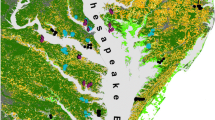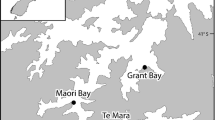Abstract
For marine biogenic habitats, such as kelp and seagrass, declines and local extinction events cause concern because of the loss of ecosystem services they provide. Many of these habitats function as valuable nurseries, but this function may be eroded when invasive species alter the structure of the habitats. For anadromous salmonids along the northeast Pacific, there is little known about the nursery role of coastal habitats, which presents a challenge for scientists to fully understand their complex life histories necessary for informing resource managers in decision-making processes regarding habitat protection and restoration. To address these issues, we ran a 3-week experiment testing the nursery functions of seagrass (Zostera marina), the invasive alga Sargassum muticum, mixed seagrass-Sargassum, and bare sand plots on the growth, survival, and prey availability for endangered Chinook salmon (Oncorhynchus tshawytscha) smolts. We found mixed effects of each habitat type when compared with each other. Chinook salmon smolts grew less in seagrass when compared with the three other habitats (bare sand, Sargassum, mixed seagrass-Sargassum). However, fish survival was lower in Sargassum habitat compared with seagrass and bare sand. Prey availability was greatest in mixed seagrass-Sargassum habitat compared with bare sand, Sargassum, or seagrass. We used a principal components analysis (PCA) to develop a nursery index using the smolts’ growth rate, percent survival, prey availability, and density of prey in gut contents. The nursery index showed that mixed seagrass-Sargassum habitat had the most positive effects on nursery performance. These results suggest that invasive species can serve positive habitat functions, but only when in the presence of a habitat-forming native species. Our study supports the theory that habitat diversity leads to greater nursery function of coastal ecosystems.




Similar content being viewed by others
References
Alford, S.B., and L.P. Rozas. 2019. Effects of nonnative Eurasian Watermilfoil, Myriophyllum spicatum, on nekton habitat quality in a Louisiana oligohaline estuary. Estuaries and Coasts 42 (3): 613–628. https://doi.org/10.1007/s12237-018-00513-x
Augerot, X., and D.N. Foley. 2005. Atlas of Pacific salmon: the first map-based status assessment of salmon in the North Pacific. Berkeley: University of California Press.
Beck, M.W., K.L. Heck Jr., K.W. Able, L. Daniel, D.B. Eggleston, Bronwyn M. Gillanders, Benjamin Halpern, et al. 2001. The identification, conservation, and management of estuarine and marine nurseries for fish and invertebrates. BioScience 51 (8): 633–641. https://doi.org/10.1641/0006-3568(2001)051[0633:TICAMO]2.0.CO;2.
Boström, C., S.J. Pittman, C. Simenstad, and R.T. Kneib. 2011. Seascape ecology of coastal biogenic habitats: advances, gaps, and challenges. Marine Ecology Progress Series 427: 191–217. https://doi.org/10.3354/meps09051.
Bottom, D.L., K.K. Jones, T.J. Cornwell, A. Gray, and C.A. Simenstad. 2005. Patterns of Chinook salmon migration and residency in the Salmon River estuary (Oregon). Estuarine, Coastal and Shelf Science 64 (1): 79–93. https://doi.org/10.1016/j.ecss.2005.02.008.
Britton-Simmons, K.H. 2004. Direct and indirect effects of the introduced alga Sargassum muticum on benthic, subtidal communities of Washington State, USA. Marine Ecology Progress Series 277: 61–78. https://doi.org/10.3354/meps277061.
Bruno, J.F., J.J. Stachowicz, and M.D. Bertness. 2003. Inclusion of facilitation into ecological theory. Trends in Ecology & Evolution 18 (3): 119–125. https://doi.org/10.1016/S0169-5347(02)00045-9.
Ceccherelli, G., and F. Cinelli. 1997. Short-term effects of nutrient enrichment of the sediment and interactions between the seagrass Cymodocea nodosa and the introduced green alga Caulerpa taxifolia in a Mediterranean bay. J Exp Mar Biol Ecol 217 (2): 165–177. https://doi.org/10.1016/S0022-0981(97)00050-6.
Demopoulos, A.W.J., B. Fry, and C.R. Smith. 2007. Food web structure in exotic and native mangroves: A Hawaii-Puerto Rico comparison. Oecologia 153 (3): 675–686. https://doi.org/10.1007/s00442-007-0751-x.
Den Hartog, C. 1997. Is Sargassum muticum a threat to eelgrass beds? Aquatic Botany 58 (1): 37–41. https://doi.org/10.1016/S0304-3770(97)00007-7
Deudero, S., A. Box, J. Alós, N. L. Arroyo, and N. Marbà. 2011. Functional changes due to invasive species: food web shifts at shallow Posidonia oceanica seagrass beds colonized by the alien macroalga Caulerpa racemosa. Estuarine, Coastal and Shelf Science 93. Elsevier Ltd: 106–116. https://doi.org/10.1016/j.ecss.2011.03.017.
Didham, R.K., J.M. Tylianakis, N.J. Gemmell, T.A. Rand, and R.M. Ewers. 2007. Interactive effects of habitat modification and species invasion on native species decline. Trends in Ecology and Evolution 22 (9): 489–496. https://doi.org/10.1016/j.tree.2007.07.001.
Emmett, R.L., S.A. Hinton, S.L. Stone, and M.E. Monaco. 1991. Distribution and abundance of fishes and invertebrates in west coast estuaries, volume II: Species life history summaries. ELMR Report No. 8 II: 329.
Fresh, K.L. 2006. Juvenile Pacific Salmon in Puget Sound. Technical report 2006-06 prepared in support of the Puget Sound Nearshore Partnership.
Gallardo, B., M. Clavero, M.I. Sánchez, and M. Vilà. 2016. Global ecological impacts of invasive species in aquatic ecosystems. Global Change Biology 22 (1): 151–163. https://doi.org/10.1111/gcb.13004.
Grabowski, J.H., A.R. Hughes, D.L. Kimbro, and M.A. Dolan. 2005. How habitat setting influences restored oyster reef communities. Ecology 86 (7): 1926–1935. https://doi.org/10.1890/04-0690.
Gratwicke, B., and M.R. Speight. 2005. The relationship between fish species richness, abundance and habitat complexity in a range of shallow tropical marine habitats. Journal of Fish Biology 66 (3): 650–667. https://doi.org/10.1111/j.0022-1112.2005.00629.x.
Groner, M.L., C.A. Burge, C.J.S. Kim, E. Rees, K.L. Van Alstyne, S. Yang, S. Wyllie-Echeverria, and C.D. Harvell. 2016. Plant characteristics associated with widespread variation in eelgrass wasting disease. Diseases of Aquatic Organisms 118: 159–168. https://doi.org/10.3354/dao02962.
Healey, M.C. 1991. Life history of Chinook salmon. In Pacific Salmon life histories, ed. C. Groot and L. Margolis, vol. 1992, 311–394. Vancouver: University of British Columbia Press. https://doi.org/10.2307/1446178.
Holsman, K.K., P.S. McDonald, P.A. Barreyro, and D.A. Armstrong. 2010. Restoration through eradication? Removal of an invasive bioengineer restores some habitat function for a native predator. Ecological Applications 20 (8): 2249–2262.
Hughes, B.B., M. Levey, J. Brown, M. Fountain, A. Carlisle, S. Litvin, W. Heady, M. Gleason, and C. Greene. 2014. Nursery functions of U.S. west coast estuaries: the state of the knowledge for juveniles of fifteen representative fish and invertebrate species. A Report for the The Nature Conservancy and the Pacific Marine and Estuarine Fish Habitat Partnership, 172 pp.
Johnson, R.C., P.K. Weber, J.D. Wikert, M.L. Workman, R.B. MacFarlane, M.J. Grove, and A.K. Schmitt. 2012. Managed metapopulations: do salmon hatchery ‘sources’ lead to in-river ‘sinks’ in conservation? PLoS One 7 (2): e28880. https://doi.org/10.1371/journal.pone.0028880.
Kennedy, L.A., F. Juanes, and R. El-Sabaawi. 2018. Eelgrass as valuable nearshore foraging habitat for juvenile Pacific salmon in the early marine period. Marine and Coastal Fisheries 10 (2): 190–203. https://doi.org/10.1002/mcf2.10018.
Lefcheck, J.S., D.J. Wilcox, R.R. Murphy, S.R. Marion, and R.J. Orth. 2017. Multiple stressors threaten the imperiled coastal foundation species eelgrass (Zostera marina) in Chesapeake Bay, USA. Global Change Biology 1–10. https://doi.org/10.1111/gcb.13623.
Litvin, S.Y., M.P. Weinstein, M. Sheaves, and I. Nagelkerken. 2018. What makes nearshore habitats nurseries for nekton? An emerging view of the nursery role hypothesis. Estuaries and Coasts 41. Springer, 1539–1550. https://doi.org/10.1007/s12237-018-0383-x.
Martin, C.W., and J.F. Valentine. 2011. Impacts of a habitat-forming exotic species on estuarine structure and function: an experimental assessment of Eurasian milfoil. Estuaries and Coasts 34 (2): 364–372. https://doi.org/10.1007/s12237-010-9274-5.
Micheli, F., and C.H. Peterson. 1999. Estuarine vegetated habitats as corridors for predator movements. Conservation Biology 13 (4): 869–881. https://doi.org/10.1046/j.1523-1739.1999.98233.x.
Molnar, J.L., R.L. Gamboa, C. Revenga, and M.D. Spalding. 2008. Assessing the global threat of invasive species to marine biodiversity. Frontiers in Ecology and the Environment 6 (9): 485–492. https://doi.org/10.1890/070064.
Moyle, P.B., J.A. Israel, and S.E. Purdy. 2008. Salmon, steelhead, and trout in California: status of an emblematic fauna. California: Davis.
Mumford, T.F. 2007. Kelp and Eelgrass in Puget Sound. Prepared in support of the Puget Sound Nearshore Partnership. 27.
Nagelkerken, I., M. Sheaves, R. Baker, and R.M. Connolly. 2013. The seascape nursery: a novel spatial approach to identify and manage nurseries for coastal marine fauna. Fish and Fisheries. 16 (2): 362–371. https://doi.org/10.1111/faf.12057.
NOAA. 2007. Puget Sound Salmon recovery plan.
Orth, R.J., T.J.B. Carruthers, W.C. Dennison, C.M. Duarte, J.W. Fourqurean, K.L. Heck, A.R. Hughes, et al. 2006. A global crisis for seagrass ecosystems. BioScience 56 (12): 987.
Pejchar, L., and H.A. Mooney. 2009. Invasive species, ecosystem services and human well-being. Trends in Ecology and Evolution 24 (9): 497–504. https://doi.org/10.1016/j.tree.2009.03.016.
Ramus, A.P., B.R. Silliman, M.S. Thomsen, and Z.T. Long. 2017. An invasive foundation species enhances multifunctionality in a coastal ecosystem. Proceedings of the National Academy of Sciences of the United States of America 114 (32): 8580–8585. https://doi.org/10.1073/pnas.1700353114.
Rogers-Bennett, L., and C.A. Catton. 2019. Marine heat wave and multiple stressors tip bull kelp forest to sea urchin barrens. Scientific Reports 9 (1): 1–9. https://doi.org/10.1038/s41598-019-51114-y.
Sheaves, M. 2009. Consequences of ecological connectivity: the coastal ecosystem mosaic. Marine Ecology Progress Series 391: 107–115. https://doi.org/10.3354/meps08121.
Shelton, A.O., T.B. Francis, B.E. Feist, G.D. Williams, A. Lindquist, and P.S. Levin. 2017. Forty years of seagrass population stability and resilience in an urbanizing estuary. Journal of Ecology 105 (2): 458–470. https://doi.org/10.1111/1365-2745.12682.
Silliman, B.R., and M.D. Bertness. 2004. Shoreline development drives invasion of Phragmites australis and the loss of plant diversity on New England salt marshes. Conservation Biology 18 (5): 1424–1434. https://doi.org/10.1111/j.1523-1739.2004.00112.x.
Simenstad, C.A., and J.R. Cordell. 2000. Ecological assessment criteria for restoring anadromous salmonid habitat in Pacific northwest estuaries. Ecological Engineering 15 (3-4): 283–302.
Sotka, E.E., and J.E. Byers. 2018. Not so fast: promoting invasive species to enhance multifunctionality in a native ecosystem requires strong(er) scrutiny. Biological Invasions 0. Springer International Publishing. https://doi.org/10.1007/s10530-018-1822-0
Toft, J.D., S.H. Munsch, J.R. Cordell, K. Siitari, V.C. Hare, B.M. Holycross, L.A. DeBruyckere, C.M. Greene, and B.B. Hughes. 2018. Impact of multiple stressors on juvenile fish in estuaries of the Northeast Pacific. Global Change Biology 24 (5): 2008–2020. https://doi.org/10.1111/gcb.14055.
Valinoti, C.E., C.K. Ho, and A.R. Armitage. 2011. Native and exotic submerged aquatic vegetation provide different nutritional and refuge values for macroinvertebrates. Journal of Experimental Marine Biology and Ecology 409 (1-2): 42–47. https://doi.org/10.1016/j.jembe.2011.08.001.
Waycott, M., C.M. Duarte, T.J.B. Carruthers, R.J. Orth, W.C. Dennison, S. Olyarnik, A. Calladine, J.W. Fourqurean, K.L. Heck, A.R. Hughes, G.A. Kendrick, W.J. Kenworthy, F.T. Short, and S.L. Williams. 2009. Accelerating loss of seagrasses across the globe threatens coastal ecosystems. Proceedings of the National Academy of Sciences of the United States of America 106 (30): 12377–12381.
Williams, S.L. 2007. Introduced species in seagrass ecosystems: status and concerns. Journal of Experimental Marine Biology and Ecology 350 (1-2): 89–110. https://doi.org/10.1016/j.jembe.2007.05.032.
Williams, S.L., and E.D. Grosholz. 2008. The invasive species challenge in estuarine and coastal environments: marrying management and science. Estuaries and Coasts 31 (1): 3–20. https://doi.org/10.1007/s12237-007-9031-6.
Acknowledgments
We are indebted to Susan Williams for being a nexus for this collaboration, but more importantly for her inspiration as a true pioneer in the field of estuarine and coastal science. We miss her adventurous spirit, leadership, and friendship and hope this manuscript honors her legacy. BBH was supported by the University of Washington—Friday Harbor Laboratories Postdoctoral Fellowship. BAA, NNN, and SGS were supported by the University of California Santa Cruz’s Doris Duke Conservation Scholars Program. All authors thank the staff of the Friday Harbor Labs for space and support for this work. Research was completed under permission from UW IACUC (PROTO201829–4238-13: Nursery Function of Coastal Puget Sound). We would like to thank the editors C. Simenstad and M.D. Taylor and two anonymous reviewers for their helpful comments. We also thank our colleagues J.J. Orth and K. Heck for organizing this special issue for a woman we all admired.
Author information
Authors and Affiliations
Corresponding author
Additional information
Communicated by Matthew D. Taylor
Rights and permissions
About this article
Cite this article
Hughes, B.B., Ali, B.A., Noor, N.J. et al. Native and Invasive Macrophytes Differ in Their Effectiveness as Nurseries for Juvenile Endangered Salmon. Estuaries and Coasts 44, 422–430 (2021). https://doi.org/10.1007/s12237-020-00845-7
Received:
Revised:
Accepted:
Published:
Issue Date:
DOI: https://doi.org/10.1007/s12237-020-00845-7




